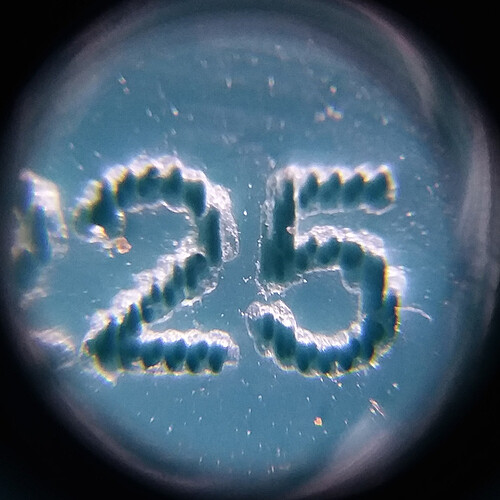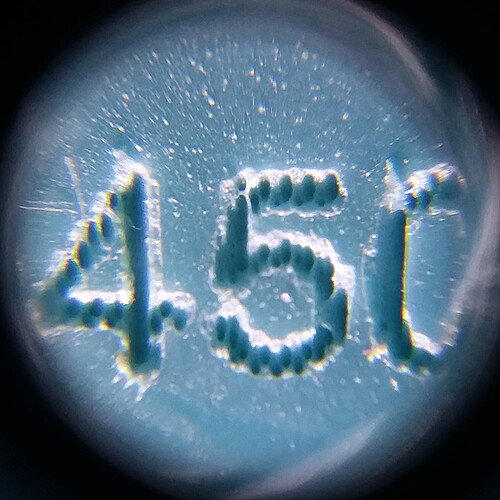This is a spinoff of off-topic discussion in thread “Print&cut-- From Inkscape SVG, how to engrave (raster) & cut (vector) superimposed correctly [Solved]” because Glowforge’s forum software doesn’t seem to allow Glowforge staff to move selected forum postings to a new thread.
Also, I’ve had to remove the hyperlink from the above paragraph because, “Sorry, new users can only put 3 links in a post.”
I will quote the relevant postings from the previous thread:
From the linked topic: (“Preparing a Photo…”)
Since jbmanning5’s tests were done with 270 LPI, and the question is, “which is better, DPI equal to LPI, or DPI = twice the LPI?,” the relevant DPI in jbmanning5’s tests would be 270 & 540. The closest offered by jbmanning5 in the “Preparing a Photo…” topic were 300 & 600 DPI, so I’ve copied-and-pasted those below:
jbmanning5’s 300-DPI closeup:
https://community.glowforge.com/uploads/short-url/rmXGNUzQg1l1ZgXyfWGT7OYhG9M.jpg
jbmanning5’s 600-DPI closeup:
https://community.glowforge.com/uploads/short-url/ox7NiyJdMAwGHQBbp495ivYhDNr.jpg
In my opinion, there isn’t any significant difference between the image quality of the 2 above photos. There is some smudging between the two P’s in the 300dpi photo, but that’s in the middle of a big triangular area of smudging (from the upper-left corner of the left-hand P to the top & bottom of the I) which could just be due to surface texture of the material, or turbulence in the ventilation airflow (depositing char onto the material). The ellipse does look a little smoother at 600dpi, but then the curves of the P’s look smoother to me at 300dpi.
The following are the test files that I made. The ZIP file contains two Inkscape SVG’s and two PDF’s, one PDF made from each SVG:
DPI = LPI versus 2 times LPI (source files).zip (45.3 KB)
The only difference between the SVGs should be that one has text saying “450 DPI” where the other SVG says “225 DPI.” Other than that, the only difference between the PDFs is that each was rasterized at the respective resolution in Inkscape’s PDF export dialog box. You’ll notice that the 450 DPI PDF has a bigger filesize.
We ran the 2 test PDFs on Glowforge teal acrylic. Each PDF was lasered in a separate run so the raster resolution of each PDF wouldn’t affect GFUI’s processing of the other. Using GFUI, we positioned the engraving areas next to each other on the same sheet of acrylic. Again, we didn’t notice any clear difference in image quality between the 2 rasterization resolutions. Following are closeups we took with the only camera the makerspace had (a handheld microscope attachment for a cellphone) that can focus that close:
I notice that this forum converted the 2 PNGs to JPEG, so here are the PNGs in a ZIP so you can view them unaltered: closeups.zip (2.6 MB)
Both closeups have a 5 in them, which can be used to compare the resolution between the 2 photos, and to me there isn’t any real difference in laser image quality.
It does look like some dust got onto the acrylic before the photos were taken, but I don’t think this should affect our opinion of the laser process.
Anyone who reads this thread is welcome to use my uploaded PDF’s to repeat my testing. I recommend using a homogeneous material that doesn’t char, such as opaque acrylic, rather than something like draftboard that can have variable surface texture & can deposit a variable amount of char downwind of the laser beam.
As to a theory of why (DPI = 2 * LPI) doesn’t seem to provide any better image quality than (DPI = LPI): The idea that DPI should be 2 * LPI seems consistent with the Nyquist Sampling Theorem, but I have another analogy. In this case, we have to fit our raster file through somebody else’s (GFUI) processing. Maybe this is like an analog voice-band landline telephone modem, in which the telco samples the line at 64kbps, and there is just no way a modem can fit more than 64kbps through that channel.

